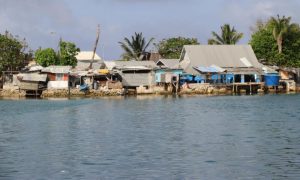Questions from the Marshall Islands 70 years after Bikini Atoll disaster, Part 4: Double hardship
Mar. 16, 2024
Rising sea levels lend reality to idea of migration
by Michio Shimotaka, Staff Writer
A taxi ride in Majuro, the capital of the Marshall Islands, a nation located in the central Pacific Ocean region, afforded me vistas of the sea on both left and right sides. The island is a partial arch-shaped atoll with a long and narrow configuration. At its narrowest, near the airport, it measures only slightly more than 30 meters wide. Even at its widest, in an area on which the capitol building stands, the land measures less than 600 meters in width. And with the rising sea levels resulting from climate change, the land is narrowing further.
On February 28, to get a sense about the reality of the situation by speaking with local residents, this reporter visited a house built along the sea. Even without prior notification of my visit, Travis Joe, 38, a government official, was friendly as he described how a seawall had been built behind his home about one year ago. Mr. Joe explained that the roughly two-meter-high seawall had been constructed by the local government. By all appearances, his single-story home seemed well protected. But with a look of resignation, Mr. Joe told me how waves at one point exceeded the seawall and reached his roof.
Ranked among world’s 10 lowest greenhouse gas-emitting nations
Mr. Joe’s home had been damaged by flooding since before the seawall was erected, making it necessary for him to consider the impacts of climate change. When I asked who might be to blame for the situation, he smiled and replied that everyone on earth was. Rethinking his response, he replied that it was the United States and Japan, likely because he was conscious of the fact I had come from Japan. According to data from the World Bank and other sources, China, India, Russia, and Brazil are the other top greenhouse-gas emitters. Meanwhile, the Marshall Islands is among the 10 lowest gas-emitting nations in the world.
There are no mountains on the Marshall Islands, which has an average elevation of around two meters. A countermeasure plan that the national government put together in October of last year warned that sea levels could rise 0.5 meters by the end of the 21st century and two meters by the middle of the 22nd century. The plan clearly states that, by the middle of this century, the government must come to a conclusion regarding whether it can realistically prepare for such conditions or adopt other strategies such as migration or seeking alternative places to live.
Evacuation from the country is a realistic option. Along with their descendants, residents who were forced from their homes due to the nuclear testing conducted by the United States during the period 1946–1958 are at risk of losing their homeland without ever being able to return.
Suspicion cannot be overcome
Jakkein Anjain, 56, who I met at the local government offices in Majuro, is one of those residents. Mr. Anjain is from Rongelap Atoll, part of an area contaminated by the ashes of death (radioactive fallout) that resulted from the “Castle Bravo” hydrogen bomb test conducted on March 1, 1954. He was born at a time during which the United States temporarily declared the area to be safe but had to leave his home when the danger of living there was revealed.
Mr. Anjain is angry that the United States did not call for evacuation during the testing, a situation that led to the residents of Rongelap, including his grandfather, being exposed to radiation. The local government is promoting a resettlement plan for the area, but Mr. Anjain is unable to rid himself of his suspicion that contamination could remain.
I asked him how he could accept the current situation in which rising sea levels might force him to once again relocate. After growing silent and mulling over the question for a while, he responded that he had no idea where he might be taken next, but that it was always that way. His disconsolate expression made me wonder whether he was challenging my responsibility as a citizen of a greenhouse gas-emitting nation.
(Originally published on March 16, 2024)








